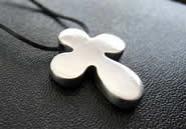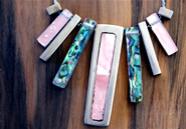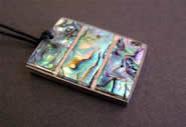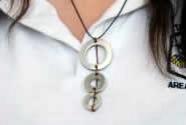Is bling still in?
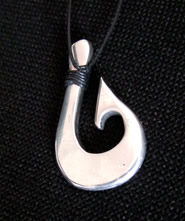
Overview
Year: 10
Level: 3
Context: Cast an item of adornment from pewter, for example, key ring, pendant, brooch.
School: Tauraroa Area School
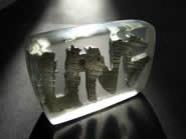
Introduction
I was keen to explore areas and starting points that weren't just a repeat of technological practice. I particularly wanted to explore the principles of design and the value of design as an experience, that is, open their eyes to how "cool" design can be. So while this unit focuses on students undertaking their own technological practice to make an outcome, I had a strong additional focus on the new strands. I found this very liberating and I was able to justify exploration into new areas that just a practice focus wouldn't allow. I even felt they didn't have to bring all of the concepts covered back into their practice to justify the work we did. I felt I was building a base of expertise for the student, but one firmly embedded in technology not just based on my hunch as to what they might need.
The theme running across all of the school's technology units is that students will: experience a wide range of materials, use mock-ups and models, and develop high quality outcomes. I got the idea for this context from Martin Basset (Kamo High school). I was looking for a unit to teach using the new strands and provide something that would suit a wide range of students as we have core classes doing technology. We don't have metal facilities at the school and this could bring a new material into the subject.
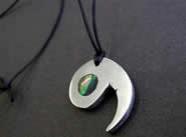
I therefore chose all three strands to be the basis for my unit design, although brief development and planning for practice achievement objectives from level 3 provided the basis for the unit learning outcomes and assessment of student progression. Aiming at around level 3 was based on my previous experience that most of these students are working between levels 2 and 4.
The most important additional component was characteristics of technology (CoT), so I developed focusing questions as my assessment strategy for this. Other focusing questions are included, but I focused on CoT.
Strands, key competencies, and values
| Technological practice | Undertake construction of an outcome focusing on learning outcomes as follows:
|
| Nature of technology | Characteristics of technology: Understand how society impacts on and is influenced by technology in historical and contemporary contexts and that technological knowledge is validated by successful function. |
| Characteristics of technological outcomes: understand that technological outcomes are recognisable as fit for purpose by the relationship between their physical and functional nature. | |
| Technological knowledge | Technological Products: understand the relationship between material and performance properties of technological products. |
Key competencies and values
- self management – staying focused, responsibility
- excellence – quality work
- integrity, respect and ecological sustainability – caring for materials, safety and workspace
- diversity – cultural responsibilities
Learning sequence and assessment strategies
Learning Sequence |
Assessment Strategies |
| (Providing support for BD and CoT) | |
| Look at PowerPoint of jewellery. What does high quality look like? How do the products change according to purpose? What's common and what's not? | Notes in folio |
| (Providing support for BD, TP, CoTO and CoT) | |
| Find pictures they like, notate on what the aesthetic qualities are, for example, line, pattern, colour, texture, shape, attempt to describe. | Annotated pictures Initial brief in folio |
| (Providing support for BD and CoT) | |
| Look at Māori shapes and design. Why are these traditional shapes for Māori? | |
| (Providing support for BD, TP, CoTO and CoT) | |
| Bring finished items to show. Undertake 'product analysis' Consider relationship between selected items physical and functional attributes, no sharp edges, tools, restrictions of Processes, hanging, strength, joining | Description in folio Homework Assignment Revised brief in folio |
| (Providing support for TP and PfP) | |
| Show casting patterns and attempted projects from past. Discuss in terms of planning processes they need to think about to ensure they have resources and time. | List of resources needed in portfolio |
| (Providing support for BD) | |
| Develop a range of design concepts for their Pewter casting item. Support drawing skills development. Highlight the functional /aesthetic/physical aspects of design drawing. Evaluate designs against brief | Concept designs in folio |
| (Providing support for PfP) | |
| Select final design to construct and identify next steps and resources required. | Selected design justified Discussion and/or updated notes evaluating what they've done, what they need to do now, materials/resources and stages of construction required in folio |
| (Providing support for PfP and BD) | |
| Construct item to a high standard. Undertake ongoing evaluations against the brief and updating plans as required to ensure time and resources are available | Refined brief (if required) Reflections on decision making captured in discussions and/or in folio |
| Evaluate item and address any issues Associated with quality, for example, finely finished, smooth shapes, elegant smooth edges, and so on. | Finished item evaluation of standard in folio |
Homework assignment and focus questions
Homework assignment
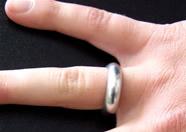
Select a product of your choice. You will need a new product and an older product of the same type.
Analyse the products in terms of physical and function natures.
Describe the differences in the products
Can you explain why they have changed? What happened?
Focus questions
Characteristics of technology
-
Why do we wear jewellery?
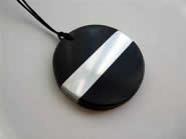
- What was its original purpose?
- Why make jewellery you can't wear?
- What are the main traditional Māori shapes? Why do you think these shapes are used?
- What is offensive to make? Was it always so?
- What special jewellery items do you have in your home?
- What are people's favourite jewellery items and why?
Characteristics of technological outcomes
-
What are the physical attributes of this item of jewellery?
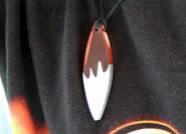
- What are the functional attributes of this item of jewellery?
- How do the physical attributes help the item function?
- How does the function of the item influence its physical appearance?
Technological products
- What materials were used to make the jewellery?
- What properties do these materials have?
- Why were these materials chosen?
-
What other materials could you have used to embed in or join to the pewter – relate to the physical properties of each material?
